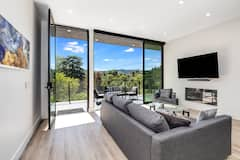It all started long ago, when Los Angeles was graduating from a river-side farming community to an urban center for film and westward expansion. Downtown’s Historic Core, sprinkled with early 20th century hotels, train depots, glamorous movie “picture palaces” and proud Fountainhead-esque office buildings, has been both an extended Hollywood backlot and a testament to the great era of Beaux Arts and Art Deco architecture for nearly a century. This may be the city that never walks, but today you’re lacing up your shoes and taking a walk through the streets.
On screen darlings are made of stucco and steel

Start at Union Station, the 1939 train station that has served as a backdrop for so many cosmic meetings and partings. You might recognize it from The Way We Were, Blade Runner or even The Dark Knight Rises. The building’s Mission Revival exterior’s defining feature is a tall, stucco bell tower. Inside, the iconic passenger waiting terminal is full of dim brown, yellow and orange hues above oversized waiting chairs. Join a Saturday morning walking tour for 10 USD to find out more.
Hop on the Red Line to Pershing Square and get off on the 4th Street side next to Angels Flight, the tiny orange rail car that lifts passengers to the top of Bunker Hill. Opened in 1901, it has lifted most passengers to the top of the hill; but for a few, it’s spelled sudden death, inspiring its appearance in Kiss Me Deadly and lots of noir literature. Admire from the safety of the street at Grand Central Market.
Step through the market to Broadway at 3rd to see the Bradbury Building. Peek inside the lobby of the 1893 Bradbury, the oldest commercial building in the central city, and see why it’s been at the center of iconic films like Blade Runner and (500) Days of Summer. Three floors of wrought-iron railings and open-cage elevators sit under a glass ceiling that fills the Victorian lobby with light from morning until night.
Big screen movie palaces recall a bygone era

Admire the view of the opulent facade of the 1918 Million Dollar Theatre, Los Angeles’ first “grand movie palace,” across the street.
Then, walk south down Broadway, past colorful bodegas and shops selling Mexican “sweet sixteen” dresses and keep looking up. Starting in 1910 with the opening of the Neoclassical Cameo Theatre, Broadway would be the center of the emerging moving picture industry until Hollywood started to move west in the 1930s, precipitating a struggle and eventual shuttering of most of these glamorous picture houses.
Your stroll will take you past the remaining marquees of the 1910s, which proudly light up jewelry and discount gadget shops today. Starting with the Million Dollar, those theatres would be outmatched by the ever-more-grand movie houses of the 1920s. The Art Deco-style Roxie, built in 1931, was the last of the era.
Now, you can walk through a bargain swap mall where the Roxie’s lobby used to be. But not all of the beauty of the interiors has been degraded and destroyed by neglect and demolition. Poke your head in on a film crew shooting in the excessively ornate French Baroque lobby of the restored 1931 Los Angeles Theatre, admire the Beaux Arts exterior or the Spanish-style interior of the 1921 State Theatre, or catch a show at the Orpheum, a 1926 vaudeville playhouse that’s now a concert venue.
Hotels tell the story of cinema history

Once you pass 9th, you’ll end your theatre-district tour at the 1927 United Artists building, named for the studio founded by Charlie Chaplin, Mary Pickford, Douglas Fairbanks and DW Griffith. Inside the Spanish-style facade is the ultra-modern Ace Hotel, which has tastefully mixed and matched original Gothic and Spanish details with its own updates. Most notably, the Ace Theatre, surrounded in spirally Gothic columns reminiscent of the Sangrada Familia, has been restored to a film, music and event space at the Ace. Ask the concierge about a tour.
Walk west on 9th to make a loop to Grand Avenue and head north. Pass 6th Street and arrive at the Biltmore Hotel, the site of many early years of the Oscars ceremony. In 1923, this statuesque Beaux Arts temple was the largest hotel west of Chicago. A mural behind the lobby desk depicts a lush, California lifestyle fit for Roman gods. Across the arcade, you’ll discover ballrooms covered in Renaissance frescoes, Baroque tapestries and Venetian glass chandeliers. Then, stop off at Rendezvous Court to see the grand, Spanish Baroque staircase. Take a comfortable seat while you order a three-tiered tray of goodies for high tea or, as Don Draper prefers in one of his many scenes shot here for “Mad Men,” an Old Fashioned.
You might be interested in these Airbnbs!
Spend a day in the past with an Historic Core tour
Spend three hours revisiting the early 1900s to see where movies were born and bred when you visit the Historic Core of Downtown Los Angeles. It’s a piece of history that has reimagined itself just as many times as directors have called “Action” and “Cut” along its streets and in its buildings.
History
Get Trip101 in your inbox
Unsubscribe in one click. See our Privacy Policy for more information on how we use your data




















Create an account to